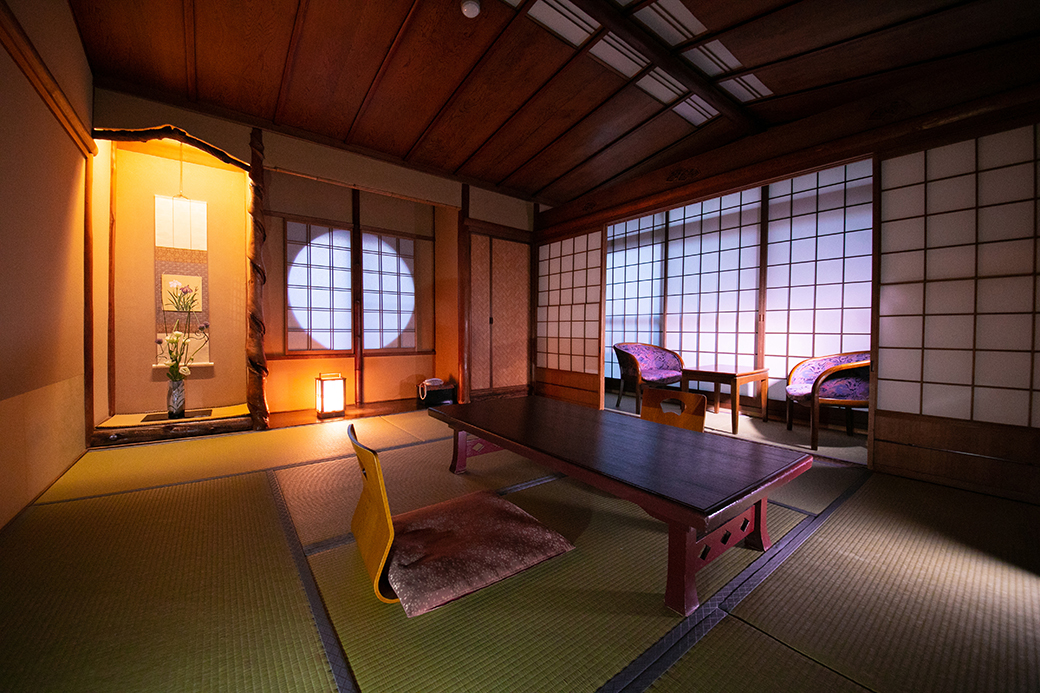Best Ryokans in Kyoto

https://commons.wikimedia.org/wiki/File:Hoshinoya_Kyoto.jpg
Do you know what ryokan is? It is a traditional Japanese inn, a low-rise wooden house served by nakai, professional room maids. It is often associated with an onsen, a bath fed with a natural hot spring, which can be placed indoors or outdoors. While you may lack some modern amenities, this will certainly be made up by the special ambience of old Japan, when people made do with a little but managed to live in harmony with nature. A typical room in a ryokan will be covered with tatamis, or mats, and have sliding doors of wood and washi paper. You will sleep on a futon, a foldable mattress, laid on the floor and dine by the coffee table, while sitting on the floor, as well. All of this may seem uncomfortable at first thought, but this way, by living the way ancient Japanese did, if only for a couple of days, you will acquaint yourself with Japan's mysterious culture and feel its minimalist and elegant essence. The same applies to the ancient city of Japan's imperial capital, Kyoto. Sometimes, this city looks like it stayed frozen in time for at least a hundred years. Where, if not there, can you immerse yourself in traditional Japanese culture? Let's review some ryokans in beautiful Kyoto and imagine staying there like people did centuries ago.
Omiya Kyoto

https://www.omiya-kyoto.com/guest-room
The five-story ryokan was established in 1716 as a temple inn for the nearby Higashi Hongan-ji Temple. It has 20 rooms decorated in the impeccable Japanese style. The sizes vary from 7.5 to 16 tatami mats lying on the floor. If you are not ready to immerse in foreign culture entirely, there are also some Japanese-Western style rooms, which combine Japanese ambiance with European beds. Additionally, Omiya offers several special rooms used for celebrations; they are the most spacious, festively decorated with lanterns or wooden elements, and can have a small rock garden. The ryokan also has two large public baths that accommodate 15 to 20 people and 20 to 30 people at once.
Hotel Iida Kyoto

http://www.hotel-iida.co.jp/en/gallery#172572
The building is situated in the vicinity of Kyoto Station as well as many public transport routes, which makes the exploration of the city convenient. As for the variety of rooms, the ryokan offers 10 sqm, 13 sqm, 12 sqm, and 18 sqm types of traditional Japanese rooms (23 altogether) and four single Western-style rooms. Some rooms are attached to the inner bathroom, and some only have a basic bathroom (with no bathtub). All the rooms are served with tea and sweets and are equipped with TVs and refrigerators. Hotel Iida has a large communal bath for 20 people and a small bathhouse for 10 people; both operate not day-long but according to the timetable.
Hokkaikan Ohanabo

https://www.ohanabo.com/en/gallery/
Located at the entrance of Higashi Hongan-ji Temple, the hotel boasts over a hundred years of history. The three-floor wooden ryokan aims for a home-like atmosphere and presents "three hospitalities" – Kyoto cuisine made of seasonal ingredients, old-styled rooms, and a small traditional bath. Hokkaikan Ohanabo has a Japanese-Western style room with a view of the temple that sleeps up to four persons; a Japanese room, with or without bathroom facilities, with space enough for a couple; and a spacious Japanese family room sleeping 3 to 6 persons. The bath adjoins the garden, which is grown with cypress trees and fragrant flowers; there are different rooms for men and women. For a quick shower, guests can make use of the 24-hour shower room.
Hiragiya and Hiragiya Bekkan (Annex)

https://www.hiiragiya.co.jp/en/room/#room-6
The 200-year-old ryokan, designated as a nationally registered tangible cultural property, welcomes guests to feel at home, which is said in the 19th-century calligraphy hanging in the hall. The main building possesses rooms designed as late Edo – early Showa period tea rooms showcasing the sukiya-zukuri style. There are 7-9 tatami mats sized rooms placing two people, eight tatami mats rooms for three people, 10 or 12 tatami mats rooms accommodating four people, and 15 tatami mats rooms for five people. All of the rooms except for the smallest type have an adjoining room. The rooms in the ryokan's new wing (12 altogether) are more contemporary but preserve traditional materials and craftsmanship. The sizes are the same, and there is a Western-style room that has two ordinary beds. All this serenity can be experienced just outside Kyoto's urban centre and next to many tourist attractions.
Biwako Ryokusuitei, Kyoto Lake Biwa Onsen


https://ryokusuitei-com-e.athp.transer.com/photoDL.html#kyakusitu
This award-winning resort in onsen ryokan (a hot spring inn) style, considered the best ryokan in Kyoto, is located not in the city itself but near Lake Biwa, which is a sought-after holiday destination because of its fantastic views. It can be reached by a suburban train coursing ОК Kosei Line, by departing from Kyoto Station and arriving at Ogoto-onsen Station, and then by a short ride on a shuttle bus. The ryokan has 69 rooms, 51 of which have access to open-air onsen baths. The ryokan offers plenty of relaxing experiences – public and private baths, baller saunas, massage, karaoke, a garden, an outdoor lobby, an indoor piano lounge, a courtyard with a magnificent water mirror, two public restaurants and a private restaurant with high-end Japanese cuisine. As for the variety of rooms, Biwako Ryokusuitei offers three Japanese-Western suites, Japanese-style rooms with a lake view, some of which possess open-air baths (twin or triple), and Japanese-Western rooms. The total capacity of the ryokan's accommodations is 345 people.
Final Thoughts
Let's finish our imaginary journey across Kyoto's best ryokans by selecting your favourite and starting to plan the actual trip. Hotelin.com offers a choice of 1,000 ryokans throughout Japan—just use the "accommodation type" filter. Embrace the Japanese heart-warming hospitality in a traditional inn, admire its charming historic interiors, and wash all your troubles away at one of their onsens. A serene and relaxing experience is guaranteed!